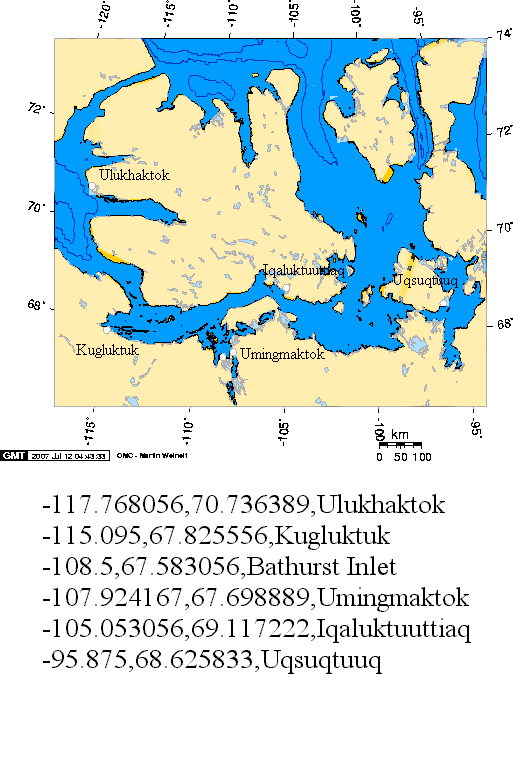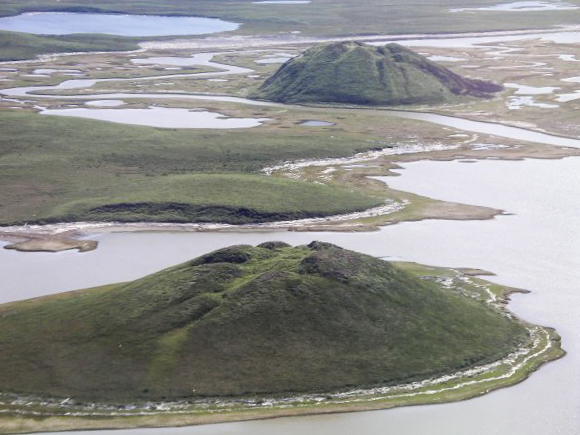|
Ulukhaktok
Ulukhaktok (Kangiryuarmiutun (Inuit languages, Inuit language) spelling ''Ulukhaqtuuq'' () and known until 1 April 2006 as ''Holman'' or ''Holman Island'') is a small Hamlet (place)#Canada, hamlet on the west coast of Victoria Island (Canada), Victoria Island, in the Inuvik Region of the Northwest Territories, Canada. Like other small traditional communities in the territories, hunting, trapping, and fishing are major sources of income, but printmaking has taken over as the primary source of income in recent years. The two principal languages in Ulukhaktok are the Kangiryuarmiutun dialect of Inuinnaqtun, which is part of the Inuvialuktun group, and English. The village has the world's most northerly golf course. The community was covered in the Inuvialuit Final Agreement as part of their Indigenous land claims in Canada, land claims and is in the Inuvialuit Settlement Region. History The first people to settle in the area were Natkusiak and his family in 1937. Two years later, ... [...More Info...] [...Related Items...] OR: [Wikipedia] [Google] [Baidu] |
Victoria Island (Canada)
Victoria Island ( ikt, Kitlineq, italic=yes) is a large island in the Arctic Archipelago that straddles the boundary between Nunavut and the Northwest Territories of Canada. It is the eighth-largest island in the world, and at in area, it is Canada's second-largest island. It is nearly double the size of Newfoundland (), and is slightly larger than the island of Great Britain () but smaller than Honshu (). The western third of the island lies in the Inuvik Region of the Northwest Territories; the remainder is part of Nunavut's Kitikmeot Region. The island is named after Queen Victoria, the Canadian sovereign from 1867 to 1901 (though she first became Queen in 1837). The features bearing the name "Prince Albert" are named after her consort, Albert. History In 1826 John Richardson saw the southwest coast and called it " Wollaston Land". In 1839 Peter Warren Dease and Thomas Simpson followed its southeast coast and called it "Victoria Land". A map published by John Barro ... [...More Info...] [...Related Items...] OR: [Wikipedia] [Google] [Baidu] |
Inuvialuit Settlement Region
The Inuvialuit Settlement Region, abbreviated as ISR ( ikt, Inuvialuit Nunangit Sannaiqtuaq – INS; french: Région désignée des Inuvialuit – RDI), located in Canada's western Arctic, was designated in 1984 in the Inuvialuit Final Agreement by the Government of Canada for the Inuvialuit people. It spans of land, mostly above the tree line, and includes several subregions: the Beaufort Sea, the Mackenzie River delta, the northern portion of Yukon ("Yukon North Slope"), and the northwest portion of the Northwest Territories. The ISR includes both Crown Lands and Inuvialuit Private Lands. The ISR is one of the four Inuit regions of Canada, collectively known as Inuit Nunangat, represented by the Inuit Tapiriit Kanatami (ITK). The other regions include Nunatsiavut in Labrador, Nunavik in northern Quebec, and the territory of Nunavut. The ISR is the homeland of the Inuvialuit. The Inuvialuit Regional Corporation, established in 1986 as the receiver of the lands and fi ... [...More Info...] [...Related Items...] OR: [Wikipedia] [Google] [Baidu] |
Kangiryuarmiutun
''Kangiryuarmiutun'' (sometimes ''Kangirjuarmiut(un)''), is a dialect of Inuit language spoken in Ulukhaktok, Northwest Territories, Canada by the Kangiryuarmiut, a Copper Inuit group. The dialect is part of the Inuvialuktun language. The people of Ulukhaktok prefer to think of it as Inuinnaqtun and it is essentially the same. It is derived from Kangiryuak (meaning "the big bay"), and named for the people that lived there, the Kangiryuarmiut, which is known by its English name Prince Albert Sound, Victoria Island Victoria Island ( ikt, Kitlineq, italic=yes) is a large island in the Arctic Archipelago that straddles the boundary between Nunavut and the Northwest Territories of Canada. It is the eighth-largest island in the world, and at in area, it is .... Victoria Island is the ancestral home of the Copper Inuit. Vocabulary comparison The comparison of some animal names in the Siglitun and Kangiryuarmiutun subdialects of the Inuinnaqtun dialect of Inuvialuktun: [...More Info...] [...Related Items...] OR: [Wikipedia] [Google] [Baidu] |
Inuvik Region
The Inuvik Region or ''Beaufort Delta Region'' is one of five administrative regions in the Northwest Territories of Canada. According to Municipal and Community Affairs the region consists of eight communities with the regional office situated in Inuvik. Most of the communities are in the Beaufort Sea area and are a mixture of Inuit (Inuvialuit) and First Nations (mostly Gwich'in). Formerly, there was also a Statistics Canada designated census division named Inuvik Region, Northwest Territories The Inuvik Region or ''Beaufort Delta Region'' is one of five administrative regions in the Northwest Territories of Canada. According to Municipal and Community Affairs the region consists of eight communities with the regional office situate ..., which was abolished in the 2011 Canadian Census. The territorial extent of this census division was somewhat larger than the administrative region of the same name. Administrative Region communities The Inuvik Region administrative e ... [...More Info...] [...Related Items...] OR: [Wikipedia] [Google] [Baidu] |
Nunakput
Nunakput is a Provinces and territories of Canada, territorial Constituency, electoral district for the Legislative Assembly of the Northwest Territories, Canada. The district consists of Paulatuk, Sachs Harbour, Tuktoyaktuk and Ulukhaktok. Members of the Legislative Assembly (MLAs) Election results 2019 election 2015 election 2011 election 2007 election 2003 election 1999 election Notes References External links [...More Info...] [...Related Items...] OR: [Wikipedia] [Google] [Baidu] |
Inuvialuktun
Inuvialuktun (part of ''Western Canadian Inuit/Inuktitut/Inuktut/Inuktun'') comprises several Inuit language varieties spoken in the northern Northwest Territories by Canadian Inuit who call themselves '' Inuvialuit''. Some dialects and sub-dialects are also spoken in Nunavut. and Distribution and varieties Inuvialuktun is spoken by the Inuit of the Mackenzie River delta, Banks Island, part of Victoria Island and the Arctic Ocean coast of the Northwest Territories – the lands of the Inuvialuit Settlement Region. It was traditionally subsumed under a broader ''Inuktitut''. Rather than a coherent language, Inuvialuktun is a politically motivated grouping of three quite distinct and separate varieties. It consists of '' Sallirmiutun'' (formerly Siglitun; Inuvialuktun proper), the '' Kangiryuarmiutun'' dialect of Inuinnaqtun on Victoria Island in the East and the '' Uummarmiutun'' dialect of Iñupiaq around Inuvik and Aklavik in the West. Inuvialuktun, Inuinnaqtun and Inu ... [...More Info...] [...Related Items...] OR: [Wikipedia] [Google] [Baidu] |
Inuinnaqtun
Inuinnaqtun (; natively meaning ''like the real human beings/peoples''), is an indigenous Inuit language. It is spoken in the central Canadian Arctic. It is related very closely to Inuktitut, and some scholars, such as Richard Condon, believe that Inuinnaqtun is more appropriately classified as a dialect of Inuktitut. The government of Nunavut recognises Inuinnaqtun as an official language in addition to Inuktitut, and together sometimes referred to as Inuktut.''Official Languages Act'', S.Nu. 2008, c. 10 s. 3(1) wit s. 1(2). It is also spoken in the |
Region 1, Northwest Territories
Region 1 is the name of a Statistics Canada census division, one of six in the Northwest Territories, Canada. It was introduced in the 2011 census, along with Regions 2, 3, 4, 5 and 6, resulting in the abolition of the former census divisions of Fort Smith Region and Inuvik Region (the latter not to be confused with the modern-day administrative region of the same name). Unlike in some other provinces, census divisions do not reflect the organization of local government in the Northwest Territories. These areas exist solely for the purposes of statistical analysis and presentation; they have no government of their own. Its territorial extent coincides with the Inuvik Region administrative region, which is somewhat smaller than the former census division of the same name. It comprises the northern and western part of the Northwest Territories, with its main economic centre in the town of Inuvik. The 2011 census reported a population of 6,712 and a land area of . Main langu ... [...More Info...] [...Related Items...] OR: [Wikipedia] [Google] [Baidu] |
Area Code 867
Area code 867 is the area code in the North American Numbering Plan (NANP) for the three Canadian territories, all of which are in Northern Canada. The area code was created on October 21, 1997, by combining numbering plan areas (NPAs) 403 and 819. As the least populated NPA in mainland North America, serving about 100,000 people, it is geographically the largest, at , with Alaska a distant second. The numbering plan area is adjacent to eight provinces (Alberta, British Columbia, Manitoba, Newfoundland and Labrador, Ontario, Saskatchewan, and Quebec) and one U.S. state (Alaska), as well as Greenland and Russia (across the North Pole), more jurisdictions than any other area code in North America. It is also one of four Canadian area codes without an overlay numbering plan, the others being 506, 709 (both of which are slated for overlays), and 807. The incumbent local exchange carrier for area code 867 is Northwestel, a subsidiary of BCE. Until 1964, the geographic area s ... [...More Info...] [...Related Items...] OR: [Wikipedia] [Google] [Baidu] |
List Of X Postal Codes Of Canada
__NOTOC__ This is a list of postal codes in Canada where the first letter is X. Postal codes beginning with X are located within the Canadian territories of Nunavut and the Northwest Territories. Only the first three characters are listed, corresponding to the Forward Sortation Area. Canada Post provides a free postal code look-up tool on its website, and its mobile applications. Many vendors also sell validation tools, which allow customers to properly match addresses and postal codes. Hard-copy directories can also be consulted in all post offices, and some libraries. Nunavut and the Northwest Territories - 6 FSAs References {{Canadian postal codes Communications in Nunavut Communications in the Northwest Territories X Postal codes Postal codes A postal code (also known locally in various English-speaking countries throughout the world as a postcode, post code, PIN or ZIP Code) is a series of letters or digits or both, sometimes including spaces or punctuation, in ... [...More Info...] [...Related Items...] OR: [Wikipedia] [Google] [Baidu] |
Hamlet (place)
A hamlet is a human settlement that is smaller than a town or village. Its size relative to a parish can depend on the administration and region. A hamlet may be considered to be a smaller settlement or subdivision or satellite entity to a larger settlement. The word and concept of a hamlet has roots in the Anglo-Norman settlement of England, where the old French ' came to apply to small human settlements. Etymology The word comes from Anglo-Norman ', corresponding to Old French ', the diminutive of Old French ' meaning a little village. This, in turn, is a diminutive of Old French ', possibly borrowed from (West Germanic) Franconian languages. Compare with modern French ', Dutch ', Frisian ', German ', Old English ' and Modern English ''home''. By country Afghanistan In Afghanistan, the counterpart of the hamlet is the qala ( Dari: قلعه, Pashto: کلي) meaning "fort" or "hamlet". The Afghan ''qala'' is a fortified group of houses, generally with its own co ... [...More Info...] [...Related Items...] OR: [Wikipedia] [Google] [Baidu] |
Provinces And Territories Of Canada
Within the geographical areas of Canada, the ten provinces and three territories are sub-national administrative divisions under the jurisdiction of the Canadian Constitution. In the 1867 Canadian Confederation, three provinces of British North America—New Brunswick, Nova Scotia, and the Province of Canada (which upon Confederation was divided into Ontario and Quebec)—united to form a federation, becoming a fully independent country over the next century. Over its history, Canada's international borders have changed several times as it has added territories and provinces, making it the world's second-largest country by area. The major difference between a Canadian province and a territory is that provinces receive their power and authority from the ''Constitution Act, 1867'' (formerly called the '' British North America Act, 1867''), whereas territorial governments are creatures of statute with powers delegated to them by the Parliament of Canada. The powers flowing from ... [...More Info...] [...Related Items...] OR: [Wikipedia] [Google] [Baidu] |



